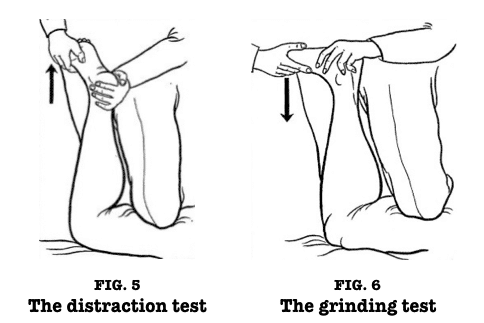Apley Test
Description
Apley test [aka the Apley grind test; Apley Compression test] is a maneuver that is performed to evaluate for meniscus injury.
Knee examination to elucidate meniscus tear by pressure and rotation of the foot with the patient lying face down and the knee flexed 90 degrees. First described by Alan Graham Apley in 1947
History of the Apley Test
1947 – Apley first described his knee examination for meniscus tear. Sensitivity and specificity for the test varies greatly, mainly due to considerable inconsistency with regards to the description of the test.
The Apley test was originally described as only applying a lateral rotation force, but is often described with a lateral and medial rotational force.
Transcript of the original test described by Apley [J Bone Joint Surg Am. 1947]
For this examination the patient lies on face down…the surgeon grasps one foot in each hand, externally rotates as far as possible, and then flexes both knees together to their limit (Fig. 3). When this limit has been reached, he changes his grasp, rotates the feet inward, and extends the knees together again.
This preliminary manoeuvre demonstrates limited rotation, painful rotation, and the exact angles of flexion at which these occur; the estimation of these angles proves useful later in the examination.
The surgeon then applies his left knee to the back of the patient’s thigh (Fig. 4). It is important to observe that in this position his weight fixes one of the levers absolutely. The foot is grasped in both hands, the knee is bent to a right angle, and powerful external rotation is applied.
This test determines whether simple rotation produces pain.
Next, without changing the position of the hands, the patient’s leg is strongly pulled upward, while the surgeon’s weight prevents the femur from rising off the couch (Fig. 5). In this position of distraction, the powerful external rotation is repeated. Two things can be determined:
- whether or not the manoeuvre produces pain and
- still more important, whether the pain is greater than in rotation alone without the distraction.
If the pain is greater, the distraction test is positive, and a rotation sprain may be diagnosed.
Then the surgeon leans well over the patient and, with his whole body weight, compresses the tibia downward onto the couch (Fig. 6). Again he rotates powerfully, and again he asks two questions:
- “Does it hurt?”
- “How much does it hurt?”
If the addition of compression has produced an increase of pain, this grinding test is positive, and meniscal damage is diagnosed. Incidentally, this question of the amount of pain is not a matter of fine hairline distinction; the patient must be sure of a considerable difference, and indeed he usually is.
2015 – Smith et al meta-analysis found Sensitivity 0.41-0.83; Specificity 0.71-0.93; LR+ 2.93-5.86 and LR- 0.23-0.63
Associated Persons
- Thomas Porter McMurray (1887 – 1949) [McMurray Test – 1942]
- Alan Graham Apley (1914–1996) [Apley Test – 1947]
Modern interpretation
Alternative names
- Apley’s test, Apley test
- Apley Compression-Distraction test
References
Original articles
- Apley AG. The diagnosis of meniscus injuries; some new clinical methods. J Bone Joint Surg Am. 1947 Jan;29(1):78-84
Modern day reviews
- Fowler PJ, Lubliner JA. The predictive value of five clinical signs in the evaluation of meniscal pathology. Arthroscopy. 1989;5(3):184-6
- Solomon DH, Simel DL, Bates DW, Katz JN, Schaffer JL. The rational clinical examination. Does this patient have a torn meniscus or ligament of the knee? Value of the physical examination. JAMA. 2001 Oct 3;286(13):1610-20.
- Karachalios T, Hantes M, Zibis AH, Zachos V, Karantanas AH, Malizos KN. Diagnostic accuracy of a new clinical test (the Thessaly test) for early detection of meniscal tears. J Bone Joint Surg Am. 2005 May;87(5):955-62
- Smith BE, Thacker D, Crewesmith A, Hall M. Special tests for assessing meniscal tears within the knee: a systematic review and meta-analysis. BMJ Evidence-Based Medicine 2015; 20: 88-97.

eponymictionary
the names behind the name
Irish doctor MB BCH BAO, NUI Gallway. Currently Emergency Medicine RMO in Perth, Western Australia. Interests in emergency medicine, GAA and exploring WA



